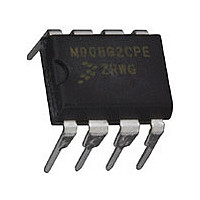MC68HC908QT2CPE Freescale, MC68HC908QT2CPE Datasheet - Page 94

MC68HC908QT2CPE
Manufacturer Part Number
MC68HC908QT2CPE
Description
Manufacturer
Freescale
Datasheet
1.MC68HC908QT2CPE.pdf
(184 pages)
Specifications of MC68HC908QT2CPE
Cpu Family
HC08
Device Core Size
8b
Frequency (max)
8MHz
Total Internal Ram Size
128Byte
# I/os (max)
6
Number Of Timers - General Purpose
2
Operating Supply Voltage (typ)
3.3/5V
Operating Supply Voltage (max)
5.5V
Operating Supply Voltage (min)
2.7V
On-chip Adc
4-chx8-bit
Instruction Set Architecture
CISC
Operating Temp Range
-40C to 85C
Operating Temperature Classification
Industrial
Mounting
Through Hole
Pin Count
8
Package Type
PDIP
Program Memory Type
Flash
Program Memory Size
1.5KB
Lead Free Status / RoHS Status
Compliant
- Current page: 94 of 184
- Download datasheet (2Mb)
Oscillator Module (OSC)
11.4.2 Crystal Amplifier Output Pin (OSC2/PTA4/BUSCLKX4)
For the XTAL oscillator device, the OSC2 pin is the crystal oscillator inverting amplifier output.
For the external clock option, the OSC2 pin is dedicated to the PTA4 I/O function. The OSC2EN bit has
no effect.
For the internal oscillator or RC oscillator options, the OSC2 pin can assume other functions according to
Table 1-3. Function Priority in Shared
Pins, or the output of the oscillator clock (BUSCLKX4).
Table 11-1. OSC2 Pin Function
Option
OSC2 Pin Function
XTAL oscillator
Inverting OSC1
External clock
PTA4 I/O
Controlled by OSC2EN bit in PTAPUE register
Internal oscillator or
OSC2EN = 0: PTA4 I/O
RC oscillator
OSC2EN = 1: BUSCLKX4 output
11.4.3 Oscillator Enable Signal (SIMOSCEN)
The SIMOSCEN signal comes from the system integration module (SIM) and enables/disables either the
XTAL oscillator circuit, the RC oscillator, or the internal oscillator.
11.4.4 XTAL Oscillator Clock (XTALCLK)
XTALCLK is the XTAL oscillator output signal. It runs at the full speed of the crystal (f
) and comes
XCLK
directly from the crystal oscillator circuit.
Figure 11-2
shows only the logical relation of XTALCLK to OSC1
and OSC2 and may not represent the actual circuitry. The duty cycle of XTALCLK is unknown and may
depend on the crystal and other external factors. Also, the frequency and amplitude of XTALCLK can be
unstable at start up.
11.4.5 RC Oscillator Clock (RCCLK)
RCCLK is the RC oscillator output signal. Its frequency is directly proportional to the time constant of
external R and internal C.
Figure 11-3
shows only the logical relation of RCCLK to OSC1 and may not
represent the actual circuitry.
11.4.6 Internal Oscillator Clock (INTCLK)
INTCLK is the internal oscillator output signal. Its nominal frequency is fixed to 12.8 MHz, but it can be
also trimmed using the oscillator trimming feature of the OSCTRIM register (see
11.3.1.1 Internal
Oscillator Trimming).
11.4.7 Oscillator Out 2 (BUSCLKX4)
BUSCLKX4 is the same as the input clock (XTALCLK, RCCLK, or INTCLK). This signal is driven to the
SIM module and is used to determine the COP cycles.
11.4.8 Oscillator Out (BUSCLKX2)
The frequency of this signal is equal to half of the BUSCLKX4, this signal is driven to the SIM for
generation of the bus clocks used by the CPU and other modules on the MCU. BUSCLKX2 will be divided
MC68HC908QY/QT Family Data Sheet, Rev. 6
94
Freescale Semiconductor
Related parts for MC68HC908QT2CPE
Image
Part Number
Description
Manufacturer
Datasheet
Request
R

Part Number:
Description:
TOWER ELEVATOR BOARDS HARDWARE
Manufacturer:
Freescale Semiconductor
Datasheet:

Part Number:
Description:
TOWER SERIAL I/O HARDWARE
Manufacturer:
Freescale Semiconductor
Datasheet:

Part Number:
Description:
LCD MODULE FOR TWR SYSTEM
Manufacturer:
Freescale Semiconductor
Datasheet:

Part Number:
Description:
DAUGHTER LCD WVGA I.MX51
Manufacturer:
Freescale Semiconductor
Datasheet:

Part Number:
Description:
TOWER SYSTEM BOARD MPC5125
Manufacturer:
Freescale Semiconductor
Datasheet:

Part Number:
Description:
KIT EVALUATION I.MX51
Manufacturer:
Freescale Semiconductor
Datasheet:

Part Number:
Description:
KIT DEVELOPMENT WINCE IMX25
Manufacturer:
Freescale Semiconductor
Datasheet:

Part Number:
Description:
TOWER SYSTEM KIT MPC5125
Manufacturer:
Freescale Semiconductor
Datasheet:

Part Number:
Description:
TOWER SYSTEM BOARD K40X256
Manufacturer:
Freescale Semiconductor
Datasheet:

Part Number:
Description:
TOWER SYSTEM KIT K40X256
Manufacturer:
Freescale Semiconductor
Datasheet:

Part Number:
Description:
Microcontrollers (MCU) MX28 PLATFORM DEV KIT
Manufacturer:
Freescale Semiconductor
Datasheet:

Part Number:
Description:
MCU, MPU & DSP Development Tools IAR KickStart Kit for Kinetis K60
Manufacturer:
Freescale Semiconductor
Datasheet:

Part Number:
Description:
24BIT HDMI MX535/08
Manufacturer:
Freescale Semiconductor
Datasheet:
Part Number:
Description:
Manufacturer:
Freescale Semiconductor, Inc
Datasheet:
Part Number:
Description:
Manufacturer:
Freescale Semiconductor, Inc
Datasheet:










